An Analysis of Australia's Biodiversity Conservation Policies
VerifiedAdded on 2019/10/30
|11
|2719
|90
Report
AI Summary
This report provides a comprehensive analysis of Australia's biodiversity policies and conservation strategies. It examines the Australia's Biodiversity Conservation Strategy 2010-2030 and the Environment Protection and Biodiversity Conservation Act 1999 (EPBC Act), highlighting their objectives and effectiveness. The report delves into key issues such as bio-banking and the protection of ecological communities, including a review of their history and development. It assesses the aims and objectives of the policies, comparing them to similar policies in the United Kingdom and the United States. The report evaluates the effectiveness of bio-banking schemes and the listing of threatened ecological communities. It also identifies shortcomings and offers recommendations for improving biodiversity conservation efforts, emphasizing the need for continued protection of ecosystems and species. This report is available on Desklib, offering valuable insights into environmental policy and conservation practices.

Name of student:
Registration number:
Name of supervisor:
Date due
Registration number:
Name of supervisor:
Date due
Paraphrase This Document
Need a fresh take? Get an instant paraphrase of this document with our AI Paraphraser
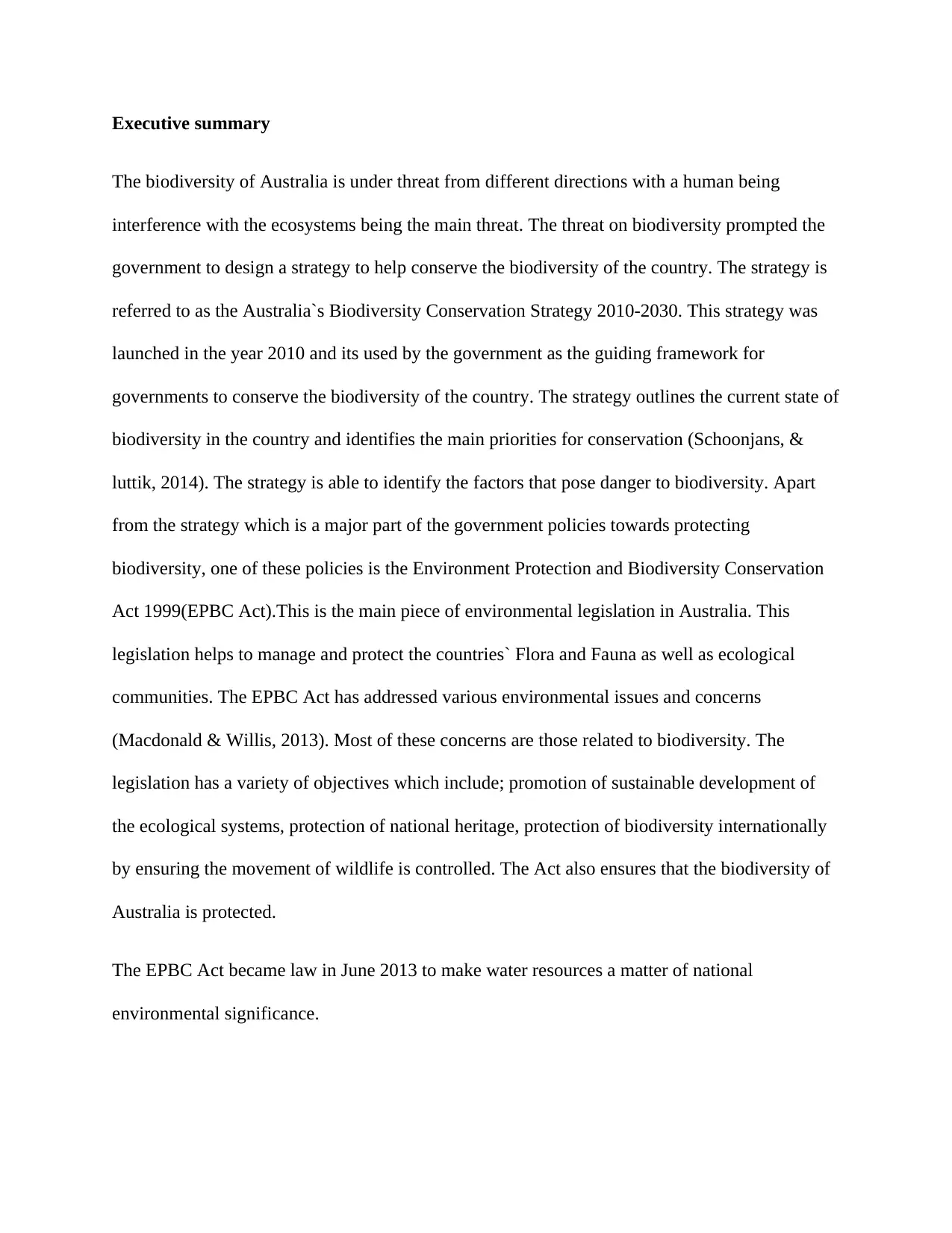
Executive summary
The biodiversity of Australia is under threat from different directions with a human being
interference with the ecosystems being the main threat. The threat on biodiversity prompted the
government to design a strategy to help conserve the biodiversity of the country. The strategy is
referred to as the Australia`s Biodiversity Conservation Strategy 2010-2030. This strategy was
launched in the year 2010 and its used by the government as the guiding framework for
governments to conserve the biodiversity of the country. The strategy outlines the current state of
biodiversity in the country and identifies the main priorities for conservation (Schoonjans, &
luttik, 2014). The strategy is able to identify the factors that pose danger to biodiversity. Apart
from the strategy which is a major part of the government policies towards protecting
biodiversity, one of these policies is the Environment Protection and Biodiversity Conservation
Act 1999(EPBC Act).This is the main piece of environmental legislation in Australia. This
legislation helps to manage and protect the countries` Flora and Fauna as well as ecological
communities. The EPBC Act has addressed various environmental issues and concerns
(Macdonald & Willis, 2013). Most of these concerns are those related to biodiversity. The
legislation has a variety of objectives which include; promotion of sustainable development of
the ecological systems, protection of national heritage, protection of biodiversity internationally
by ensuring the movement of wildlife is controlled. The Act also ensures that the biodiversity of
Australia is protected.
The EPBC Act became law in June 2013 to make water resources a matter of national
environmental significance.
The biodiversity of Australia is under threat from different directions with a human being
interference with the ecosystems being the main threat. The threat on biodiversity prompted the
government to design a strategy to help conserve the biodiversity of the country. The strategy is
referred to as the Australia`s Biodiversity Conservation Strategy 2010-2030. This strategy was
launched in the year 2010 and its used by the government as the guiding framework for
governments to conserve the biodiversity of the country. The strategy outlines the current state of
biodiversity in the country and identifies the main priorities for conservation (Schoonjans, &
luttik, 2014). The strategy is able to identify the factors that pose danger to biodiversity. Apart
from the strategy which is a major part of the government policies towards protecting
biodiversity, one of these policies is the Environment Protection and Biodiversity Conservation
Act 1999(EPBC Act).This is the main piece of environmental legislation in Australia. This
legislation helps to manage and protect the countries` Flora and Fauna as well as ecological
communities. The EPBC Act has addressed various environmental issues and concerns
(Macdonald & Willis, 2013). Most of these concerns are those related to biodiversity. The
legislation has a variety of objectives which include; promotion of sustainable development of
the ecological systems, protection of national heritage, protection of biodiversity internationally
by ensuring the movement of wildlife is controlled. The Act also ensures that the biodiversity of
Australia is protected.
The EPBC Act became law in June 2013 to make water resources a matter of national
environmental significance.
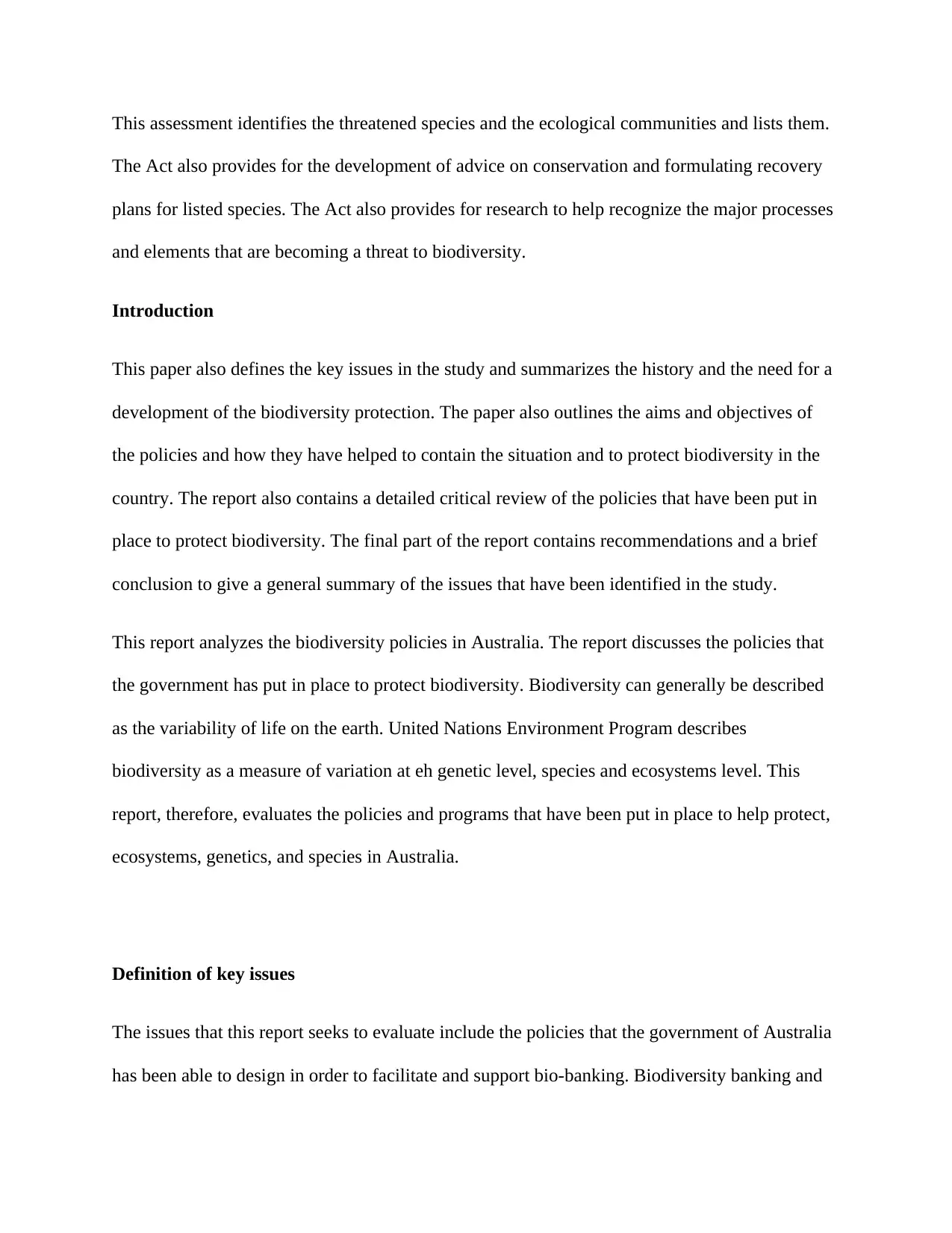
This assessment identifies the threatened species and the ecological communities and lists them.
The Act also provides for the development of advice on conservation and formulating recovery
plans for listed species. The Act also provides for research to help recognize the major processes
and elements that are becoming a threat to biodiversity.
Introduction
This paper also defines the key issues in the study and summarizes the history and the need for a
development of the biodiversity protection. The paper also outlines the aims and objectives of
the policies and how they have helped to contain the situation and to protect biodiversity in the
country. The report also contains a detailed critical review of the policies that have been put in
place to protect biodiversity. The final part of the report contains recommendations and a brief
conclusion to give a general summary of the issues that have been identified in the study.
This report analyzes the biodiversity policies in Australia. The report discusses the policies that
the government has put in place to protect biodiversity. Biodiversity can generally be described
as the variability of life on the earth. United Nations Environment Program describes
biodiversity as a measure of variation at eh genetic level, species and ecosystems level. This
report, therefore, evaluates the policies and programs that have been put in place to help protect,
ecosystems, genetics, and species in Australia.
Definition of key issues
The issues that this report seeks to evaluate include the policies that the government of Australia
has been able to design in order to facilitate and support bio-banking. Biodiversity banking and
The Act also provides for the development of advice on conservation and formulating recovery
plans for listed species. The Act also provides for research to help recognize the major processes
and elements that are becoming a threat to biodiversity.
Introduction
This paper also defines the key issues in the study and summarizes the history and the need for a
development of the biodiversity protection. The paper also outlines the aims and objectives of
the policies and how they have helped to contain the situation and to protect biodiversity in the
country. The report also contains a detailed critical review of the policies that have been put in
place to protect biodiversity. The final part of the report contains recommendations and a brief
conclusion to give a general summary of the issues that have been identified in the study.
This report analyzes the biodiversity policies in Australia. The report discusses the policies that
the government has put in place to protect biodiversity. Biodiversity can generally be described
as the variability of life on the earth. United Nations Environment Program describes
biodiversity as a measure of variation at eh genetic level, species and ecosystems level. This
report, therefore, evaluates the policies and programs that have been put in place to help protect,
ecosystems, genetics, and species in Australia.
Definition of key issues
The issues that this report seeks to evaluate include the policies that the government of Australia
has been able to design in order to facilitate and support bio-banking. Biodiversity banking and
⊘ This is a preview!⊘
Do you want full access?
Subscribe today to unlock all pages.

Trusted by 1+ million students worldwide
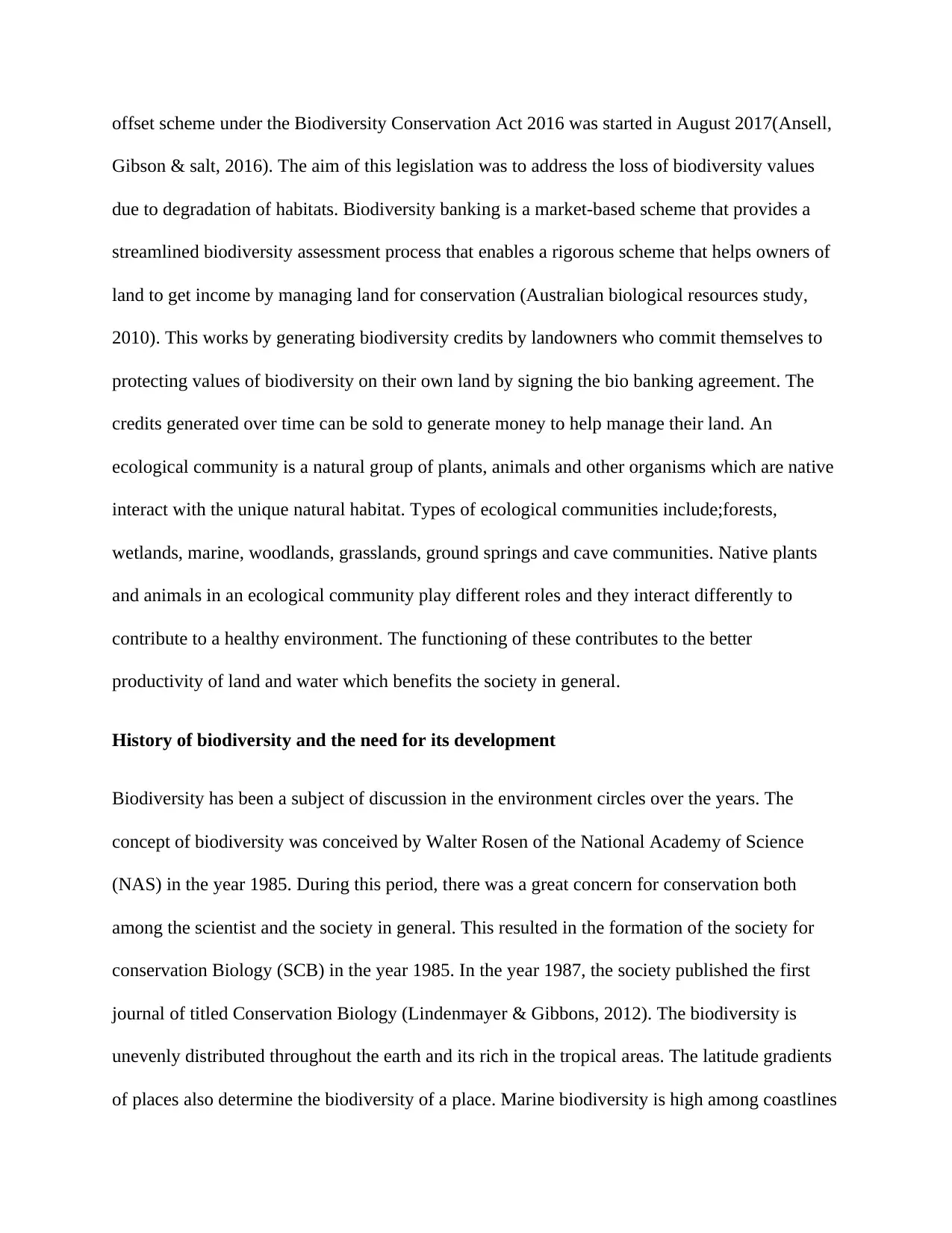
offset scheme under the Biodiversity Conservation Act 2016 was started in August 2017(Ansell,
Gibson & salt, 2016). The aim of this legislation was to address the loss of biodiversity values
due to degradation of habitats. Biodiversity banking is a market-based scheme that provides a
streamlined biodiversity assessment process that enables a rigorous scheme that helps owners of
land to get income by managing land for conservation (Australian biological resources study,
2010). This works by generating biodiversity credits by landowners who commit themselves to
protecting values of biodiversity on their own land by signing the bio banking agreement. The
credits generated over time can be sold to generate money to help manage their land. An
ecological community is a natural group of plants, animals and other organisms which are native
interact with the unique natural habitat. Types of ecological communities include;forests,
wetlands, marine, woodlands, grasslands, ground springs and cave communities. Native plants
and animals in an ecological community play different roles and they interact differently to
contribute to a healthy environment. The functioning of these contributes to the better
productivity of land and water which benefits the society in general.
History of biodiversity and the need for its development
Biodiversity has been a subject of discussion in the environment circles over the years. The
concept of biodiversity was conceived by Walter Rosen of the National Academy of Science
(NAS) in the year 1985. During this period, there was a great concern for conservation both
among the scientist and the society in general. This resulted in the formation of the society for
conservation Biology (SCB) in the year 1985. In the year 1987, the society published the first
journal of titled Conservation Biology (Lindenmayer & Gibbons, 2012). The biodiversity is
unevenly distributed throughout the earth and its rich in the tropical areas. The latitude gradients
of places also determine the biodiversity of a place. Marine biodiversity is high among coastlines
Gibson & salt, 2016). The aim of this legislation was to address the loss of biodiversity values
due to degradation of habitats. Biodiversity banking is a market-based scheme that provides a
streamlined biodiversity assessment process that enables a rigorous scheme that helps owners of
land to get income by managing land for conservation (Australian biological resources study,
2010). This works by generating biodiversity credits by landowners who commit themselves to
protecting values of biodiversity on their own land by signing the bio banking agreement. The
credits generated over time can be sold to generate money to help manage their land. An
ecological community is a natural group of plants, animals and other organisms which are native
interact with the unique natural habitat. Types of ecological communities include;forests,
wetlands, marine, woodlands, grasslands, ground springs and cave communities. Native plants
and animals in an ecological community play different roles and they interact differently to
contribute to a healthy environment. The functioning of these contributes to the better
productivity of land and water which benefits the society in general.
History of biodiversity and the need for its development
Biodiversity has been a subject of discussion in the environment circles over the years. The
concept of biodiversity was conceived by Walter Rosen of the National Academy of Science
(NAS) in the year 1985. During this period, there was a great concern for conservation both
among the scientist and the society in general. This resulted in the formation of the society for
conservation Biology (SCB) in the year 1985. In the year 1987, the society published the first
journal of titled Conservation Biology (Lindenmayer & Gibbons, 2012). The biodiversity is
unevenly distributed throughout the earth and its rich in the tropical areas. The latitude gradients
of places also determine the biodiversity of a place. Marine biodiversity is high among coastlines
Paraphrase This Document
Need a fresh take? Get an instant paraphrase of this document with our AI Paraphraser
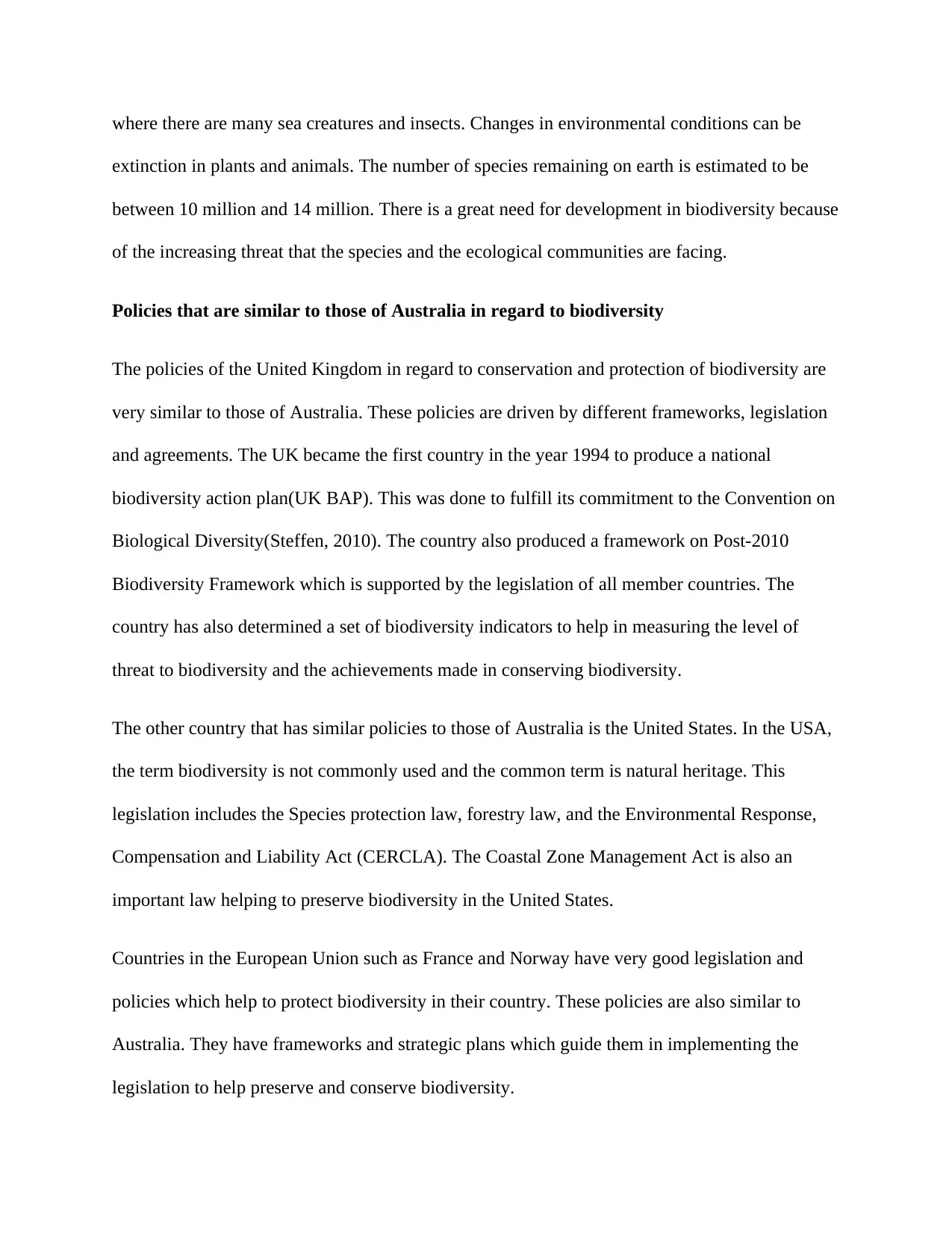
where there are many sea creatures and insects. Changes in environmental conditions can be
extinction in plants and animals. The number of species remaining on earth is estimated to be
between 10 million and 14 million. There is a great need for development in biodiversity because
of the increasing threat that the species and the ecological communities are facing.
Policies that are similar to those of Australia in regard to biodiversity
The policies of the United Kingdom in regard to conservation and protection of biodiversity are
very similar to those of Australia. These policies are driven by different frameworks, legislation
and agreements. The UK became the first country in the year 1994 to produce a national
biodiversity action plan(UK BAP). This was done to fulfill its commitment to the Convention on
Biological Diversity(Steffen, 2010). The country also produced a framework on Post-2010
Biodiversity Framework which is supported by the legislation of all member countries. The
country has also determined a set of biodiversity indicators to help in measuring the level of
threat to biodiversity and the achievements made in conserving biodiversity.
The other country that has similar policies to those of Australia is the United States. In the USA,
the term biodiversity is not commonly used and the common term is natural heritage. This
legislation includes the Species protection law, forestry law, and the Environmental Response,
Compensation and Liability Act (CERCLA). The Coastal Zone Management Act is also an
important law helping to preserve biodiversity in the United States.
Countries in the European Union such as France and Norway have very good legislation and
policies which help to protect biodiversity in their country. These policies are also similar to
Australia. They have frameworks and strategic plans which guide them in implementing the
legislation to help preserve and conserve biodiversity.
extinction in plants and animals. The number of species remaining on earth is estimated to be
between 10 million and 14 million. There is a great need for development in biodiversity because
of the increasing threat that the species and the ecological communities are facing.
Policies that are similar to those of Australia in regard to biodiversity
The policies of the United Kingdom in regard to conservation and protection of biodiversity are
very similar to those of Australia. These policies are driven by different frameworks, legislation
and agreements. The UK became the first country in the year 1994 to produce a national
biodiversity action plan(UK BAP). This was done to fulfill its commitment to the Convention on
Biological Diversity(Steffen, 2010). The country also produced a framework on Post-2010
Biodiversity Framework which is supported by the legislation of all member countries. The
country has also determined a set of biodiversity indicators to help in measuring the level of
threat to biodiversity and the achievements made in conserving biodiversity.
The other country that has similar policies to those of Australia is the United States. In the USA,
the term biodiversity is not commonly used and the common term is natural heritage. This
legislation includes the Species protection law, forestry law, and the Environmental Response,
Compensation and Liability Act (CERCLA). The Coastal Zone Management Act is also an
important law helping to preserve biodiversity in the United States.
Countries in the European Union such as France and Norway have very good legislation and
policies which help to protect biodiversity in their country. These policies are also similar to
Australia. They have frameworks and strategic plans which guide them in implementing the
legislation to help preserve and conserve biodiversity.
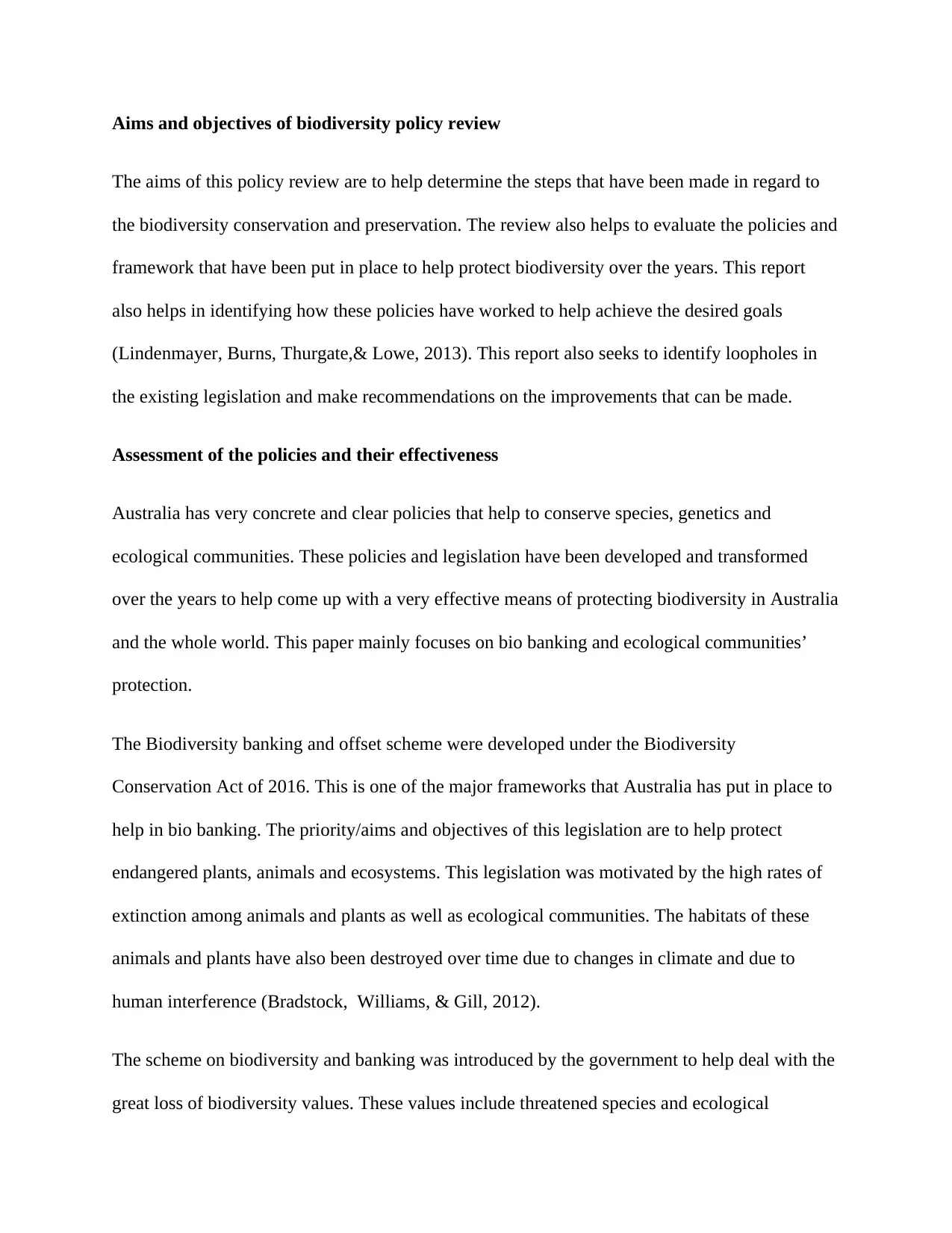
Aims and objectives of biodiversity policy review
The aims of this policy review are to help determine the steps that have been made in regard to
the biodiversity conservation and preservation. The review also helps to evaluate the policies and
framework that have been put in place to help protect biodiversity over the years. This report
also helps in identifying how these policies have worked to help achieve the desired goals
(Lindenmayer, Burns, Thurgate,& Lowe, 2013). This report also seeks to identify loopholes in
the existing legislation and make recommendations on the improvements that can be made.
Assessment of the policies and their effectiveness
Australia has very concrete and clear policies that help to conserve species, genetics and
ecological communities. These policies and legislation have been developed and transformed
over the years to help come up with a very effective means of protecting biodiversity in Australia
and the whole world. This paper mainly focuses on bio banking and ecological communities’
protection.
The Biodiversity banking and offset scheme were developed under the Biodiversity
Conservation Act of 2016. This is one of the major frameworks that Australia has put in place to
help in bio banking. The priority/aims and objectives of this legislation are to help protect
endangered plants, animals and ecosystems. This legislation was motivated by the high rates of
extinction among animals and plants as well as ecological communities. The habitats of these
animals and plants have also been destroyed over time due to changes in climate and due to
human interference (Bradstock, Williams, & Gill, 2012).
The scheme on biodiversity and banking was introduced by the government to help deal with the
great loss of biodiversity values. These values include threatened species and ecological
The aims of this policy review are to help determine the steps that have been made in regard to
the biodiversity conservation and preservation. The review also helps to evaluate the policies and
framework that have been put in place to help protect biodiversity over the years. This report
also helps in identifying how these policies have worked to help achieve the desired goals
(Lindenmayer, Burns, Thurgate,& Lowe, 2013). This report also seeks to identify loopholes in
the existing legislation and make recommendations on the improvements that can be made.
Assessment of the policies and their effectiveness
Australia has very concrete and clear policies that help to conserve species, genetics and
ecological communities. These policies and legislation have been developed and transformed
over the years to help come up with a very effective means of protecting biodiversity in Australia
and the whole world. This paper mainly focuses on bio banking and ecological communities’
protection.
The Biodiversity banking and offset scheme were developed under the Biodiversity
Conservation Act of 2016. This is one of the major frameworks that Australia has put in place to
help in bio banking. The priority/aims and objectives of this legislation are to help protect
endangered plants, animals and ecosystems. This legislation was motivated by the high rates of
extinction among animals and plants as well as ecological communities. The habitats of these
animals and plants have also been destroyed over time due to changes in climate and due to
human interference (Bradstock, Williams, & Gill, 2012).
The scheme on biodiversity and banking was introduced by the government to help deal with the
great loss of biodiversity values. These values include threatened species and ecological
⊘ This is a preview!⊘
Do you want full access?
Subscribe today to unlock all pages.

Trusted by 1+ million students worldwide
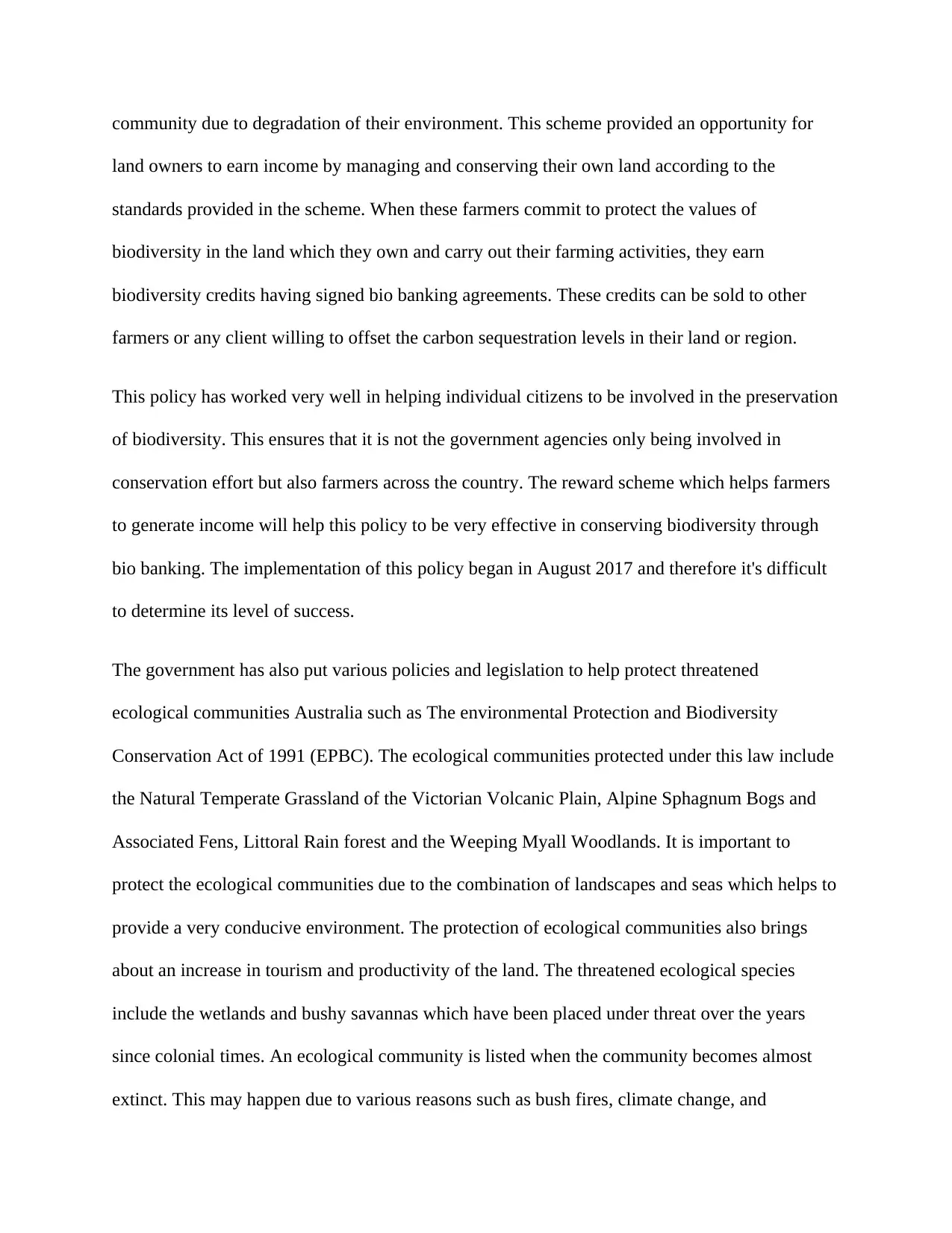
community due to degradation of their environment. This scheme provided an opportunity for
land owners to earn income by managing and conserving their own land according to the
standards provided in the scheme. When these farmers commit to protect the values of
biodiversity in the land which they own and carry out their farming activities, they earn
biodiversity credits having signed bio banking agreements. These credits can be sold to other
farmers or any client willing to offset the carbon sequestration levels in their land or region.
This policy has worked very well in helping individual citizens to be involved in the preservation
of biodiversity. This ensures that it is not the government agencies only being involved in
conservation effort but also farmers across the country. The reward scheme which helps farmers
to generate income will help this policy to be very effective in conserving biodiversity through
bio banking. The implementation of this policy began in August 2017 and therefore it's difficult
to determine its level of success.
The government has also put various policies and legislation to help protect threatened
ecological communities Australia such as The environmental Protection and Biodiversity
Conservation Act of 1991 (EPBC). The ecological communities protected under this law include
the Natural Temperate Grassland of the Victorian Volcanic Plain, Alpine Sphagnum Bogs and
Associated Fens, Littoral Rain forest and the Weeping Myall Woodlands. It is important to
protect the ecological communities due to the combination of landscapes and seas which helps to
provide a very conducive environment. The protection of ecological communities also brings
about an increase in tourism and productivity of the land. The threatened ecological species
include the wetlands and bushy savannas which have been placed under threat over the years
since colonial times. An ecological community is listed when the community becomes almost
extinct. This may happen due to various reasons such as bush fires, climate change, and
land owners to earn income by managing and conserving their own land according to the
standards provided in the scheme. When these farmers commit to protect the values of
biodiversity in the land which they own and carry out their farming activities, they earn
biodiversity credits having signed bio banking agreements. These credits can be sold to other
farmers or any client willing to offset the carbon sequestration levels in their land or region.
This policy has worked very well in helping individual citizens to be involved in the preservation
of biodiversity. This ensures that it is not the government agencies only being involved in
conservation effort but also farmers across the country. The reward scheme which helps farmers
to generate income will help this policy to be very effective in conserving biodiversity through
bio banking. The implementation of this policy began in August 2017 and therefore it's difficult
to determine its level of success.
The government has also put various policies and legislation to help protect threatened
ecological communities Australia such as The environmental Protection and Biodiversity
Conservation Act of 1991 (EPBC). The ecological communities protected under this law include
the Natural Temperate Grassland of the Victorian Volcanic Plain, Alpine Sphagnum Bogs and
Associated Fens, Littoral Rain forest and the Weeping Myall Woodlands. It is important to
protect the ecological communities due to the combination of landscapes and seas which helps to
provide a very conducive environment. The protection of ecological communities also brings
about an increase in tourism and productivity of the land. The threatened ecological species
include the wetlands and bushy savannas which have been placed under threat over the years
since colonial times. An ecological community is listed when the community becomes almost
extinct. This may happen due to various reasons such as bush fires, climate change, and
Paraphrase This Document
Need a fresh take? Get an instant paraphrase of this document with our AI Paraphraser
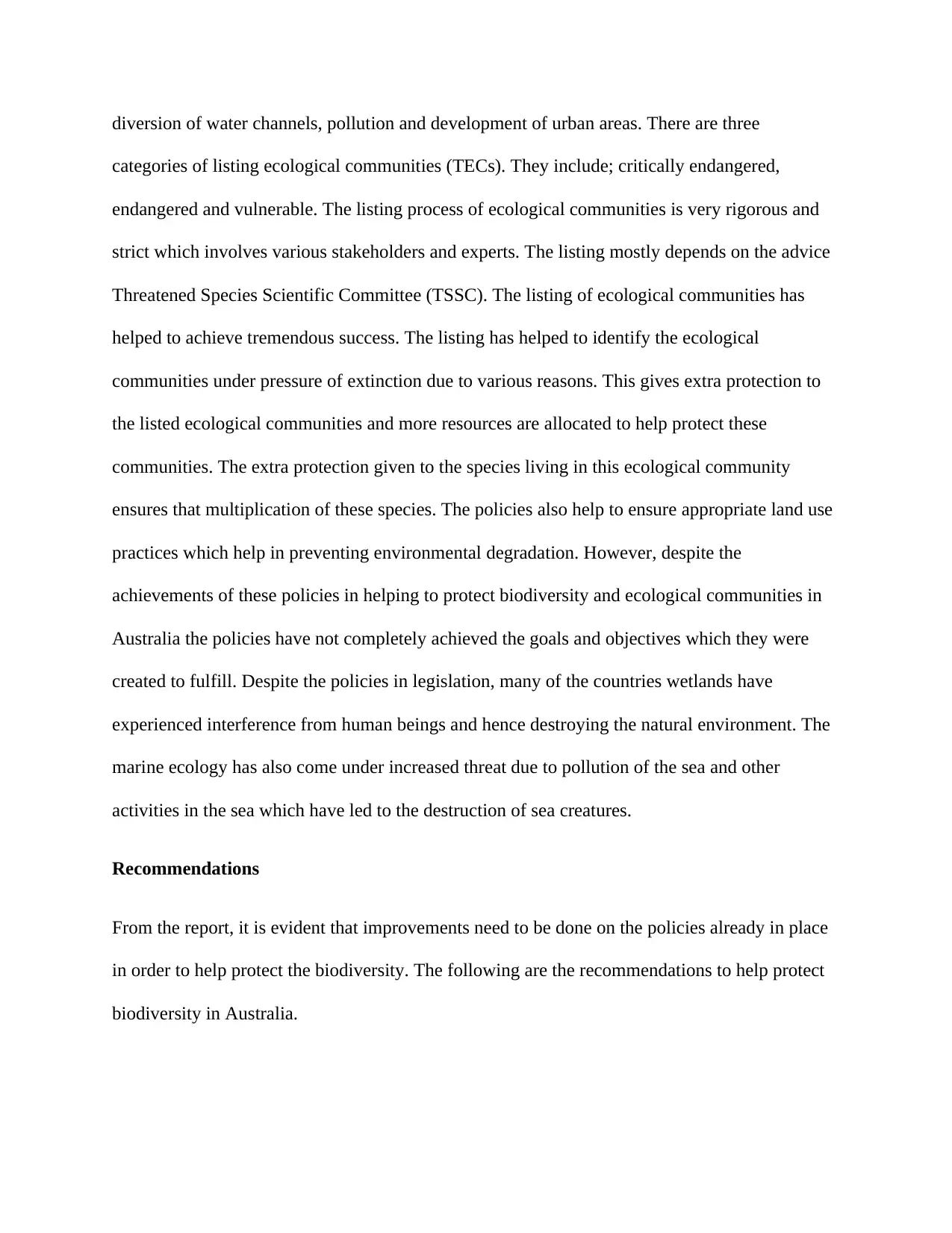
diversion of water channels, pollution and development of urban areas. There are three
categories of listing ecological communities (TECs). They include; critically endangered,
endangered and vulnerable. The listing process of ecological communities is very rigorous and
strict which involves various stakeholders and experts. The listing mostly depends on the advice
Threatened Species Scientific Committee (TSSC). The listing of ecological communities has
helped to achieve tremendous success. The listing has helped to identify the ecological
communities under pressure of extinction due to various reasons. This gives extra protection to
the listed ecological communities and more resources are allocated to help protect these
communities. The extra protection given to the species living in this ecological community
ensures that multiplication of these species. The policies also help to ensure appropriate land use
practices which help in preventing environmental degradation. However, despite the
achievements of these policies in helping to protect biodiversity and ecological communities in
Australia the policies have not completely achieved the goals and objectives which they were
created to fulfill. Despite the policies in legislation, many of the countries wetlands have
experienced interference from human beings and hence destroying the natural environment. The
marine ecology has also come under increased threat due to pollution of the sea and other
activities in the sea which have led to the destruction of sea creatures.
Recommendations
From the report, it is evident that improvements need to be done on the policies already in place
in order to help protect the biodiversity. The following are the recommendations to help protect
biodiversity in Australia.
categories of listing ecological communities (TECs). They include; critically endangered,
endangered and vulnerable. The listing process of ecological communities is very rigorous and
strict which involves various stakeholders and experts. The listing mostly depends on the advice
Threatened Species Scientific Committee (TSSC). The listing of ecological communities has
helped to achieve tremendous success. The listing has helped to identify the ecological
communities under pressure of extinction due to various reasons. This gives extra protection to
the listed ecological communities and more resources are allocated to help protect these
communities. The extra protection given to the species living in this ecological community
ensures that multiplication of these species. The policies also help to ensure appropriate land use
practices which help in preventing environmental degradation. However, despite the
achievements of these policies in helping to protect biodiversity and ecological communities in
Australia the policies have not completely achieved the goals and objectives which they were
created to fulfill. Despite the policies in legislation, many of the countries wetlands have
experienced interference from human beings and hence destroying the natural environment. The
marine ecology has also come under increased threat due to pollution of the sea and other
activities in the sea which have led to the destruction of sea creatures.
Recommendations
From the report, it is evident that improvements need to be done on the policies already in place
in order to help protect the biodiversity. The following are the recommendations to help protect
biodiversity in Australia.
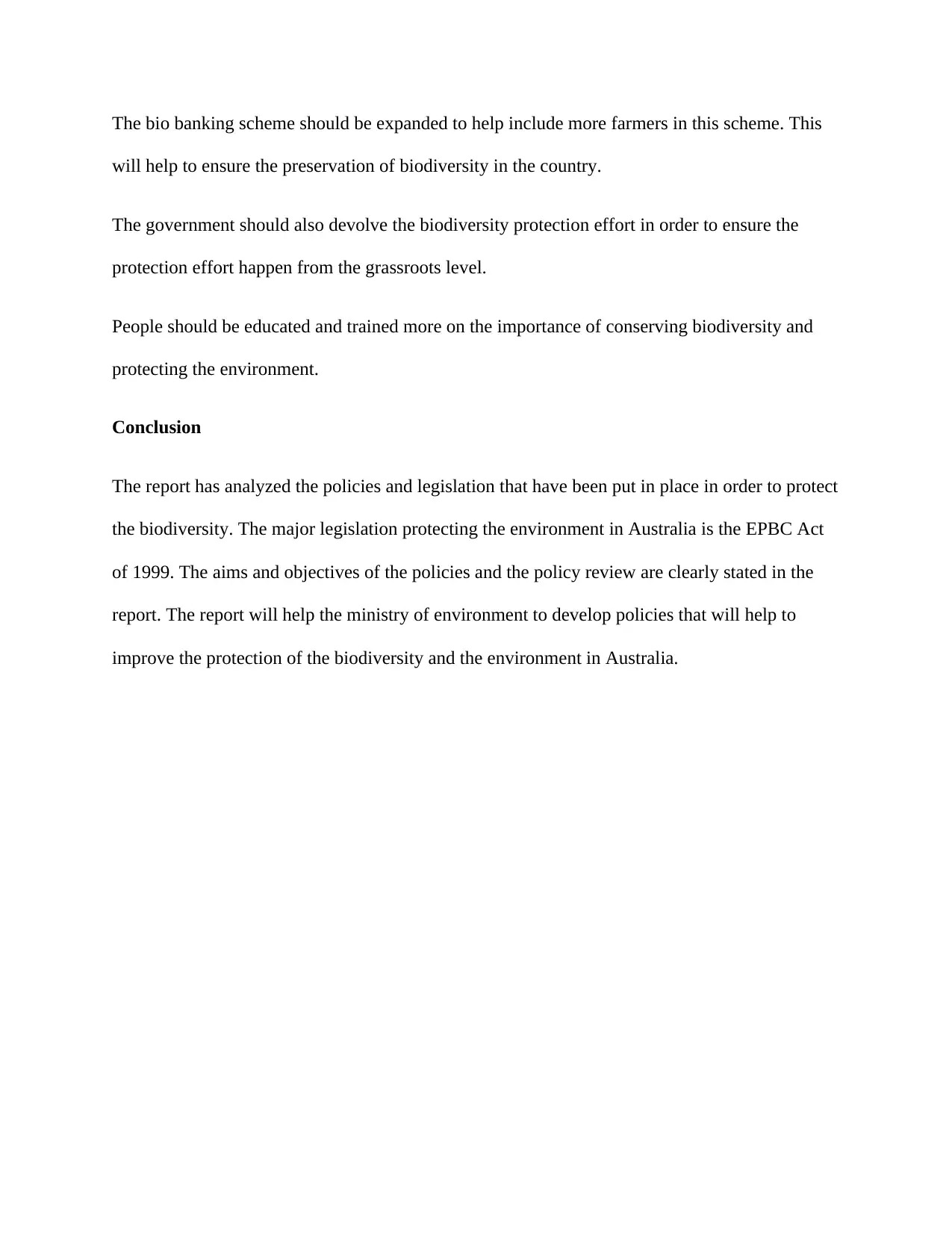
The bio banking scheme should be expanded to help include more farmers in this scheme. This
will help to ensure the preservation of biodiversity in the country.
The government should also devolve the biodiversity protection effort in order to ensure the
protection effort happen from the grassroots level.
People should be educated and trained more on the importance of conserving biodiversity and
protecting the environment.
Conclusion
The report has analyzed the policies and legislation that have been put in place in order to protect
the biodiversity. The major legislation protecting the environment in Australia is the EPBC Act
of 1999. The aims and objectives of the policies and the policy review are clearly stated in the
report. The report will help the ministry of environment to develop policies that will help to
improve the protection of the biodiversity and the environment in Australia.
will help to ensure the preservation of biodiversity in the country.
The government should also devolve the biodiversity protection effort in order to ensure the
protection effort happen from the grassroots level.
People should be educated and trained more on the importance of conserving biodiversity and
protecting the environment.
Conclusion
The report has analyzed the policies and legislation that have been put in place in order to protect
the biodiversity. The major legislation protecting the environment in Australia is the EPBC Act
of 1999. The aims and objectives of the policies and the policy review are clearly stated in the
report. The report will help the ministry of environment to develop policies that will help to
improve the protection of the biodiversity and the environment in Australia.
⊘ This is a preview!⊘
Do you want full access?
Subscribe today to unlock all pages.

Trusted by 1+ million students worldwide
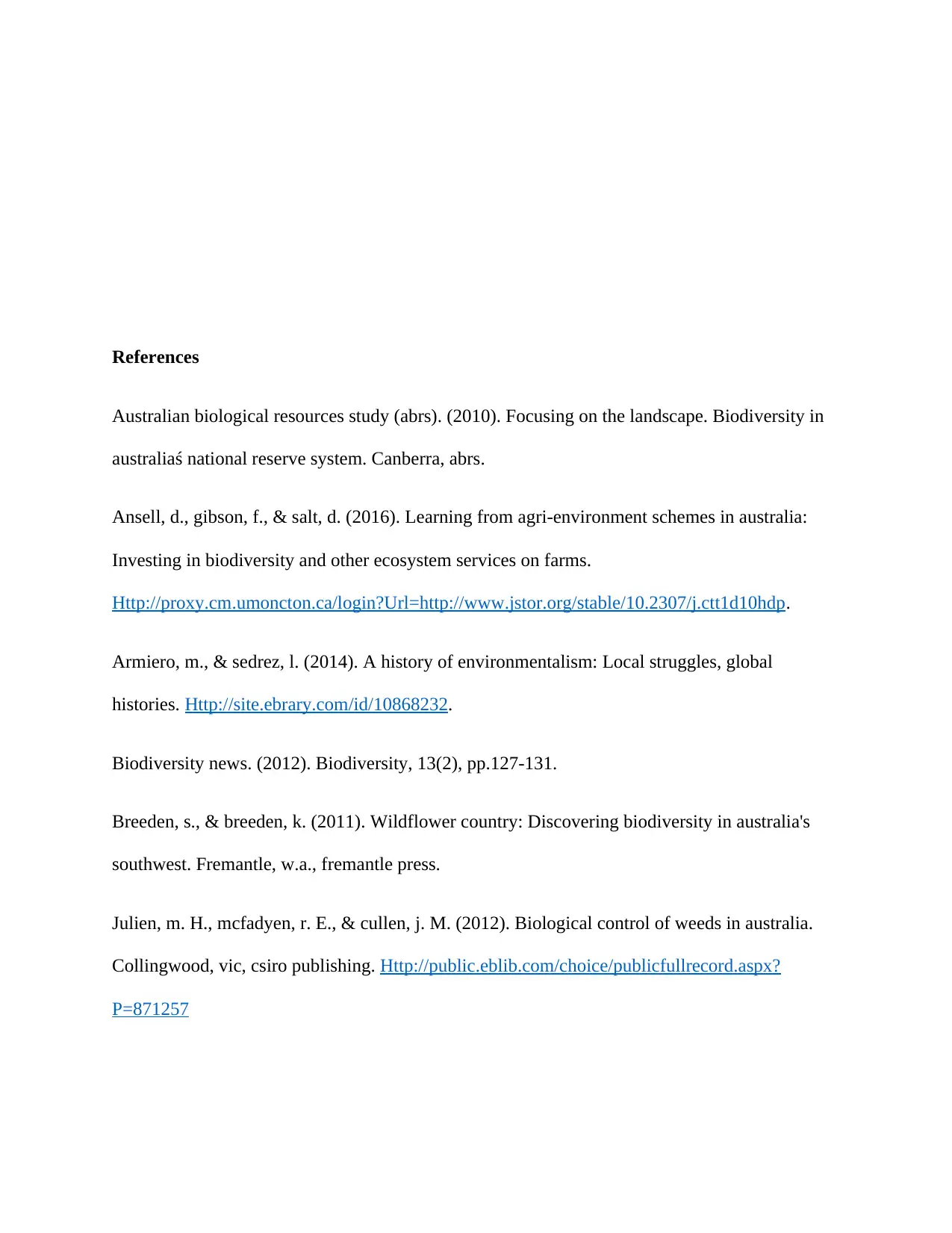
References
Australian biological resources study (abrs). (2010). Focusing on the landscape. Biodiversity in
australiaś national reserve system. Canberra, abrs.
Ansell, d., gibson, f., & salt, d. (2016). Learning from agri-environment schemes in australia:
Investing in biodiversity and other ecosystem services on farms.
Http://proxy.cm.umoncton.ca/login?Url=http://www.jstor.org/stable/10.2307/j.ctt1d10hdp.
Armiero, m., & sedrez, l. (2014). A history of environmentalism: Local struggles, global
histories. Http://site.ebrary.com/id/10868232.
Biodiversity news. (2012). Biodiversity, 13(2), pp.127-131.
Breeden, s., & breeden, k. (2011). Wildflower country: Discovering biodiversity in australia's
southwest. Fremantle, w.a., fremantle press.
Julien, m. H., mcfadyen, r. E., & cullen, j. M. (2012). Biological control of weeds in australia.
Collingwood, vic, csiro publishing. Http://public.eblib.com/choice/publicfullrecord.aspx?
P=871257
Australian biological resources study (abrs). (2010). Focusing on the landscape. Biodiversity in
australiaś national reserve system. Canberra, abrs.
Ansell, d., gibson, f., & salt, d. (2016). Learning from agri-environment schemes in australia:
Investing in biodiversity and other ecosystem services on farms.
Http://proxy.cm.umoncton.ca/login?Url=http://www.jstor.org/stable/10.2307/j.ctt1d10hdp.
Armiero, m., & sedrez, l. (2014). A history of environmentalism: Local struggles, global
histories. Http://site.ebrary.com/id/10868232.
Biodiversity news. (2012). Biodiversity, 13(2), pp.127-131.
Breeden, s., & breeden, k. (2011). Wildflower country: Discovering biodiversity in australia's
southwest. Fremantle, w.a., fremantle press.
Julien, m. H., mcfadyen, r. E., & cullen, j. M. (2012). Biological control of weeds in australia.
Collingwood, vic, csiro publishing. Http://public.eblib.com/choice/publicfullrecord.aspx?
P=871257
Paraphrase This Document
Need a fresh take? Get an instant paraphrase of this document with our AI Paraphraser
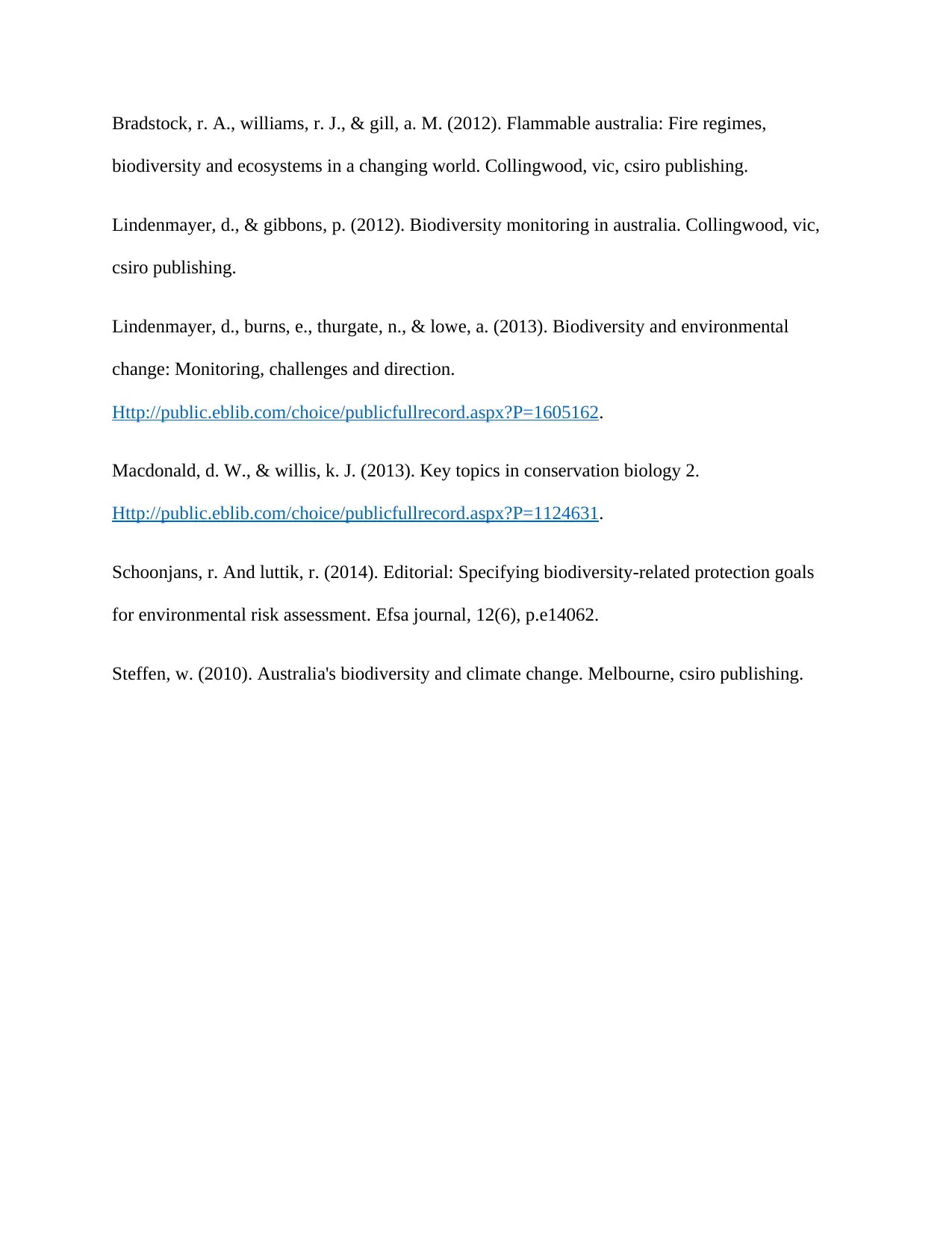
Bradstock, r. A., williams, r. J., & gill, a. M. (2012). Flammable australia: Fire regimes,
biodiversity and ecosystems in a changing world. Collingwood, vic, csiro publishing.
Lindenmayer, d., & gibbons, p. (2012). Biodiversity monitoring in australia. Collingwood, vic,
csiro publishing.
Lindenmayer, d., burns, e., thurgate, n., & lowe, a. (2013). Biodiversity and environmental
change: Monitoring, challenges and direction.
Http://public.eblib.com/choice/publicfullrecord.aspx?P=1605162.
Macdonald, d. W., & willis, k. J. (2013). Key topics in conservation biology 2.
Http://public.eblib.com/choice/publicfullrecord.aspx?P=1124631.
Schoonjans, r. And luttik, r. (2014). Editorial: Specifying biodiversity-related protection goals
for environmental risk assessment. Efsa journal, 12(6), p.e14062.
Steffen, w. (2010). Australia's biodiversity and climate change. Melbourne, csiro publishing.
biodiversity and ecosystems in a changing world. Collingwood, vic, csiro publishing.
Lindenmayer, d., & gibbons, p. (2012). Biodiversity monitoring in australia. Collingwood, vic,
csiro publishing.
Lindenmayer, d., burns, e., thurgate, n., & lowe, a. (2013). Biodiversity and environmental
change: Monitoring, challenges and direction.
Http://public.eblib.com/choice/publicfullrecord.aspx?P=1605162.
Macdonald, d. W., & willis, k. J. (2013). Key topics in conservation biology 2.
Http://public.eblib.com/choice/publicfullrecord.aspx?P=1124631.
Schoonjans, r. And luttik, r. (2014). Editorial: Specifying biodiversity-related protection goals
for environmental risk assessment. Efsa journal, 12(6), p.e14062.
Steffen, w. (2010). Australia's biodiversity and climate change. Melbourne, csiro publishing.
1 out of 11
Related Documents
Your All-in-One AI-Powered Toolkit for Academic Success.
+13062052269
info@desklib.com
Available 24*7 on WhatsApp / Email
![[object Object]](/_next/static/media/star-bottom.7253800d.svg)
Unlock your academic potential
Copyright © 2020–2025 A2Z Services. All Rights Reserved. Developed and managed by ZUCOL.





